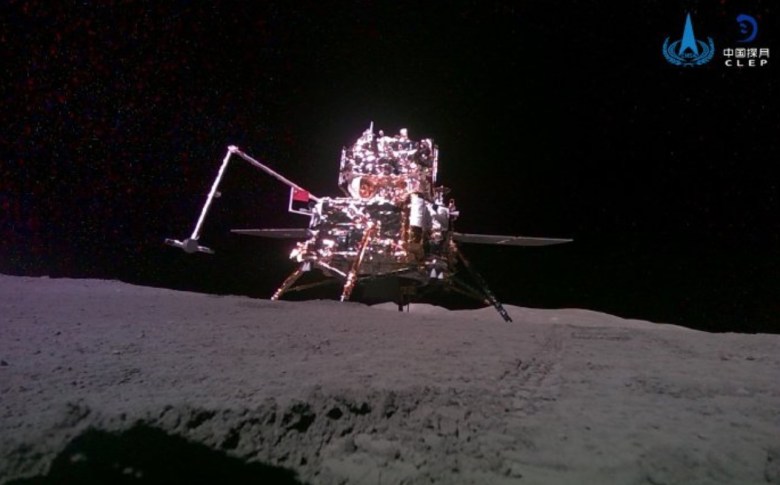HELSINKI — An ascent vehicle docked with the Chang’e-6 service module Thursday, in a critical step towards bringing the first lunar far side samples to Earth.
The lunar orbit rendezvous and docking was completed at 2:48 a.m. Eastern (0648 UTC) June 6, the China National Space Administration (CNSA) announced. Transfer of a lunar material container to a reentry module was completed at 3:24 a.m.
The Chang’e-6 orbiter will next jettison the ascent vehicle, which will then be deorbited into the moon. The orbiter, or service module, will remain in lunar orbit for around two weeks, awaiting a window for a return to Earth. It will release the reentry capsule for reentry and landing in Siziwang Banner, Inner Mongolia around June 25.
The robotic lunar orbit rendezvous is only the second such operation conducted, following the 2020 Chang’e-5 mission. The docking path, rather than a direct return, mirrors aspects of the Apollo mission profile, and is as such applicable practice and experience for China’s plans to put astronauts on the moon before the end of the decade.
China launched the complex, four-spacecraft Chang’e-6 mission May 3. A lander, topped with an ascent vehicle, separated from the orbiter and landed in Apollo crater on the lunar far side late June 1.
The lander collected samples with a scoop and drill. These were loaded the samples into the ascent vehicle. The ascender lifted off with up to 2,000 grams of unique samples just over 49 hours after the landing, making four orbital adjustments. The orbiter used short-range autonomous control to complete the orbital rendezvous, according to CNSA.

The reentry module will be released shortly before the orbiter returns to Earth. The reentry capsule will skip off the atmosphere to kill some of the energy of a high velocity return from the moon. It will then make its reentry into Earth’s atmosphere.
Recovered lunar far side samples could contain material ejected from deep below the moon’s crust, as well as from multiple impact sources. These could provide insight into why the near and far sides are so different, and clues about the history of the early solar system.
The Chang’e-6 orbiter meanwhile will likely be sent on an extended mission, depending upon propellant reserves. The Chang’e-5 orbiter visited Sun-Earth Lagrange point 1 before returning to the moon to test out a distant retrograde orbit.
Chang’e-6 is part of China’s fourth phase of lunar exploration. The country will follow up with two missions to the south pole of the moon. These are Chang’e-7 in 2026 and Chang’e-8—an in-situ resource utilization and technology test—around 2028.
The latter pair will serve as a basis for the China-led International Lunar Research Station (ILRS) program. A number of countries and organizations have signed up to the project.
| Mission Name | Launch Date | Mission Type | Objectives | Outcome |
| Chang’e 1 | October 24, 2007 | Orbiter | Lunar mapping, study lunar surface and environment | Successful; created a 3D map of the moon. |
| Chang’e 2 | October 1, 2010 | Orbiter | High-resolution imaging of lunar surface, study of Lagrange Point L2 | Successful; achieved its objectives. |
| Chang’e 3 | December 1, 2013 | Lander and Rover | Soft landing on the moon, surface exploration with the Yutu rover | Successful; Yutu rover lost mobility but operated for 31 months. |
| Chang’e 5-T1 | October 23, 2014 | Test Flight | Test re-entry technology for Chang’e 5 sample return mission | Successful; validated re-entry capsule design. |
| Chang’e 4 | December 7, 2018 | Lander and Rover | First soft landing on the far side of the moon, surface exploration with Yutu-2 rover | Successful; ongoing mission. |
| Chang’e 5 | November 23, 2020 | Near side sample Return Mission | Collect lunar samples and return them to Earth | Successful; returned 1.731 kg of samples. |
| Chang’e 6 | May 3, 2024 | Far side sample Return Mission | Collect samples from the far side of the moon and return them to Earth | Ongoing mission. |
| Chang’e 7 (planned) | NET 2026 | Orbiter, Lander, Rover, Hopper | Comprehensive lunar exploration including polar regions | Planned mission. |
| Chang’e 8 (planned) | NET 2028 | Technology Demonstration | Test key technologies for lunar base construction | Planned mission. |



